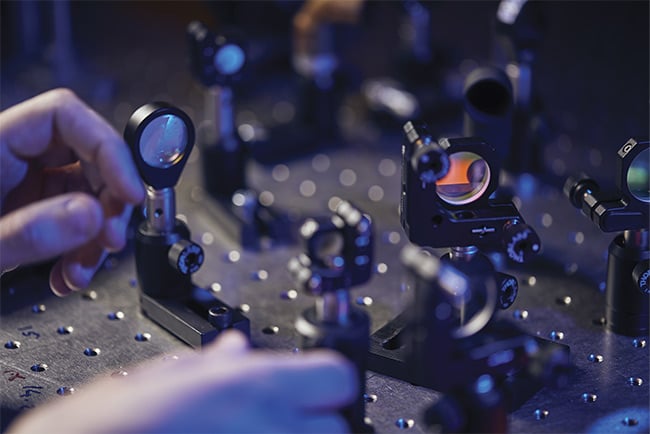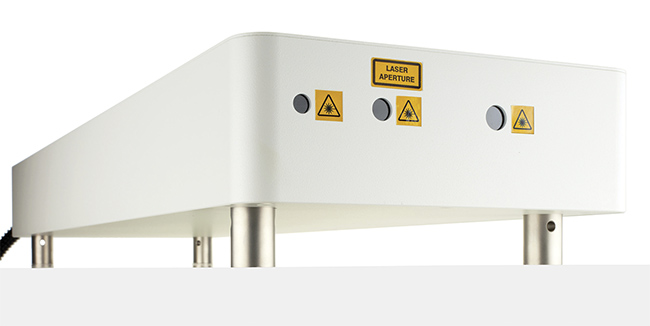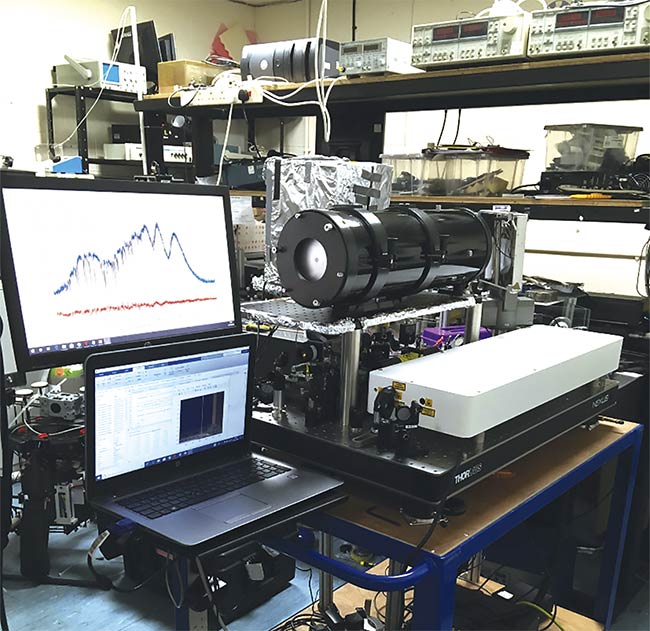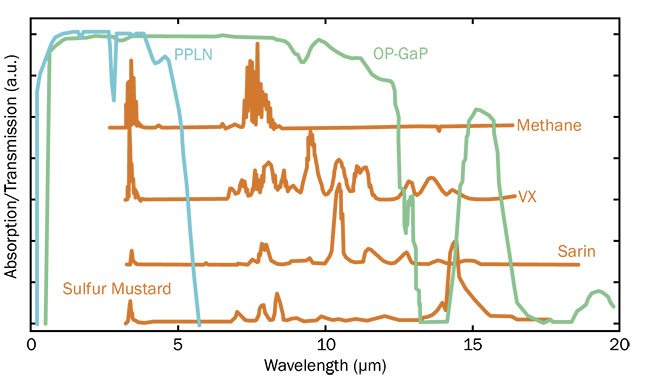
Ultrafast Lasers Probe the Fingerprint Region
Ultrashort-pulse lasers that emit in the mid-IR range promise expanded capabilities for identifying chemical signatures across the molecular fingerprint region.
CHRISTOPHER LEBURN, CHROMACITY LTD.
Twenty years ago, spectroscopists typically relied on a toolbox of analytical techniques to collect the data needed to make measurements. From gas chromatography and mass spectrometry to high-performance liquid chromatography and nuclear magnetic resonance imaging, these techniques were time-consuming and expensive to implement, and they required bulky equipment.

After initially making use of ultrafast light sources that operate in the visible and near-infrared ranges, the field of optical spectroscopy is beginning to take advantage of sources that operate in the mid-infrared spectrum from 3 to 15 µm, opening up a host of new markets and applications. Courtesy of Chromacity.
Over the past decade, the growing demand for faster, higher-resolution, and more precise spectroscopy tools — coupled with developments in ultrafast laser technology — has contributed to a resurgence in the use of optical techniques. For applications that require rapid quantification and qualification of chemicals present in the atmosphere, for example, vibrational techniques such as Raman spectroscopy are replacing slower methods. Consequently, these faster approaches are now widely used in sectors ranging from food safety and agriculture to petrochemical and pharmaceutical.
After initially making use of light sources in the visible and near-infrared range, the field of optical spectroscopy is beginning to take advantage of sources that operate in the mid-infrared (MIR) spectrum from 3 to 15 µm, opening up a host of new markets and applications.

Compared to orientation-patterned gallium arsenide (OPGaAs)-based semiconductors, newer orientation-patterned gallium phosphide (OPGaP) materials are enabling spectroscopic light sources that can probe across the 5- to 12-µm region. The high brightness of these sources also enables stand-off detection, by which a range of chemical signatures can be qualified and quantified with few-parts-per-billion resolutions at a significant distance from the instrument detector head. Courtesy of Chromacity.
The so-called molecular fingerprint region refers to wavelengths between 5 and 15 µm, where more complex chemical compounds have very structured signatures. Identifying these chemicals and distinguishing them from each other requires high-resolution spectroscopy using laser sources that span the fingerprint region.
Ultrashort revolution
Ultrashort-pulse lasers for optical spectroscopy have progressed significantly since the development of the Kerr-lens mode-locked Ti:sapphire laser.
The broader the optical bandwidth that a laser can support, the shorter the pulse duration it can generate. This ability increases the scope for higher peak powers, which, in turn, increase the prospect of generating nonlinear effects in other materials to leverage techniques such as difference-frequency generation (DFG). DFG was the first approach that laser manufacturers typically employed to generate wavelengths in the MIR region to satisfy the growing demand for high-resolution data sets.
In DFG, two frequencies interact to generate photons at lower energy but longer wavelength. The lower the energy of photons, the longer the wavelength of light they generate, which enables the ability to shift toward generation of light in the MIR region. For example, correctly synchronizing the pulses of a mode-locked 1-µm laser source with those of a 1.5-µm source and directing them through a nonlinear crystal at the right time can produce light at wavelengths beyond 3 µm and up to 5 µm if the 1.5-µm source is tuned to shorter wavelengths. Sources in this range are suitable for several spectroscopy appli-cations. Light hydrocarbons such as methane and ethane, for example, share
a number of important chemical signatures in this range.
However, because DFG is a single-pass nonlinear process, the power it generates
is typically low, so the process is inefficient. Thus, it is often viewed as an expensive technique.
From OPAs to QCLs
The low power generation of DFG sources ultimately led to the development of solutions that made use of greater optical power, including optical parametric amplifiers (OPAs), which produce significantly higher pulse energies. The optical parametric process operates at a lower pulse repetition frequency. By spreading the overall average power into fewer pulses, the energy of each pulse increases, which enables better nonlinear conversion into the MIR. However, OPAs have a large footprint, they’re inherently expensive, and the level of complexity involved in operating the system typically requires a laser physicist.

For spectroscopy applications that require high brightness and broad tunability, researchers often turn to optical parametric oscillators (OPOs), which are tunable over large wavelength ranges. OPOs typically incorporate nonlinear crystals, such as periodically poled lithium niobate (PPLN) or potassium titanyl phosphate (KTP). But the transparency window of these crystals limits their ability to generate light beyond 5 µm. Courtesy of Chromacity.
More recently, quantum cascade lasers (QCLs) have emerged as an alternative in the MIR wavelength region. They are able to probe beyond 5 or 6 µm, where DFG-based systems have struggled. QCLs are not ultrashort-pulse sources per se. They are semiconductor-based laser devices that operate in the nanosecond domain, typically with kilohertz pulse repetition frequencies. This means that their pulse energies can be low. Furthermore, QCLs emit within a narrow spectral bandwidth, and thus offer a limited tuning capability when compared to an ultrafast laser source.
QCLs have been an attractive option for spectroscopists who are particularly interested in the molecular fingerprint region. Because of the unique narrow bandwidth across this wavelength region, however, chemical compounds with complex signatures — such as the nerve agents sarin and Novichok — are difficult to detect without a light source that can reach farther into the MIR spectrum.
The compact nature and attractive price point of QCLs gave them a competitive advantage in the early days over OPAs and DFG systems. But QCLs impose other considerations. Their nanosecond pulses give them inherently narrower bandwidth, and they lack tunability, which limits their wavelength coverage. Ultimately, this lack limits their ability to characterize multiple chemical signatures without employing a whole bank of QCLs coupled into a larger spectroscopy setup.
The development of supercontinuum lasers presented an additional source for probing wavelengths in the MIR. Passing very short pulses of light from a standard light source — at 1 µm, for example — through specialized photonic crystal fibers creates nonlinear effects through a four-wave mixing process. Through this process, the light shifts to longer wavelengths as it passes through the fiber. So 1-µm light enters the fiber and exits at significantly longer wavelengths with a broader spectral bandwidth.
However, because the bandwidth of the original pulse is spread out and shifted to longer wavelengths, the power per nanometer is typically low, although it can
be enough for spectroscopy applications
that require sub-parts-per-million sensitivity, such as multicomponent gas detection of concentrations of acetylene and methane1.
Mind the OPGaP
For spectroscopy applications that require high brightness and broad tunability, researchers often turn to optical parametric oscillators (OPOs). One of the main benefits of these sources is that they generate two laser lines — known as the signal and the idler. These systems are tunable over large wavelength ranges. They typically incorporate nonlinear crystals, such as periodically poled lithium niobate (PPLN) or potassium titanyl phosphate (KTP). But the transparency window of these crystals limits their ability to generate light beyond 5 µm.

A Fourier transform infrared (FTIR) spectroscopy multispecies gas detection experiment, enabled by next-generation PPLN-based OPOs that can generate high-brightness light across the 1.4- to 4-µm spectral region. The combined system, including the OPO and spectrometer, fits on a 60- × 90-cm breadboard, making it easy to transport. This opens up significant opportunities for the development of a cost-effective and highly portable environmental multigas analyzing solution. Courtesy of Chromacity.
At the turn of the century, the development of a new nonlinear crystal called orientation-patterned gallium arsenide (OPGaAs) provided the platform for new developments in MIR light sources. OPGaAs is a semiconductor that can be inserted within an OPO cavity. When pumped with short-pulse laser systems, it produces a phase-matching condition that generates MIR light between 5 and 8 µm.
Because the OPGaAs material is confined within a resonant OPO cavity, it can be optically excited with significant intensity, which allows generation of much higher power levels. In addition, it can be pumped with a high repetition rate of short pulses, allowing it to generate many more pulses at higher intensities across the mid-IR.
In more recent years, a new material called orientation-patterned gallium phosphide (OPGaP) has offered an alternative to OPGaAs2. The benefit of OPGaP is that it enables generation of light across the 5- to 12-µm region. A further advantage is its capability to be pumped by a 1-µm laser. This enhances its potential for commercialization because it can utilize the advantages of highly efficient ytterbium-doped fibers to generate laser gain in the 1.03- to 1.08-µm range. OPGaP subsequently enabled the development of an MIR laser source that produces stable, broad-bandwidth, high-power light across the molecular fingerprint regime. At a third of the cost and a fraction of the size of an OPA, OPGaP-based systems can bring this capability to a wider audience.

The absorption spectra of complex molecules. The molecules show readily identifiable features across the 5- to 12-µm region, far beyond the gain bandwidth of PPLN. The longer mid-IR wavelengths that can be generated by OPGaP introduce compelling options for probing the molecular fingerprint region. Image adapted from Reference 3. Courtesy of Erik R. Deutsch et al.
The broadband capabilities of an OPGaP source enable the identification of several important chemical signatures in a single scan, accurate to resolutions of parts per billion. Further, it can do so without the need to tune, filter, or change the laser source. The higher brightness of an OPGaP system versus QCLs also means that the signal-to-noise ratio is significantly better, which is always an important factor for spectroscopy measurements.
Applications
The benefit of OPGaP is that it enables generation of light across the 5- to 12-µm region.
The high brightness of OPGaP-based sources enables standoff detection, by which a range of chemical signatures can be qualified and quantified with few-parts-per-billion resolutions at a significant distance from the instrument detector head. The high pulse repetition rate of OPGaP OPOs, combined with algorithms able to deconvolve the signal from these setups, further enables real-time refresh rates in the subsecond realm. This has relevance in multiple application markets, including pharmaceuticals, energy, health care, security, and defense.
A key application for sources that target the fingerprint regime is Fourier transform infrared spectroscopy (FTIR). Security and defense organizations have shown increasing interest in FTIR’s ability to identify signatures of chemicals, such as the nerve agents sarin and VX,
at a safe distance, in whatever state they are in: gas, liquid, gel, or solid.
In health care, a mid-IR laser source enables the development of breath analysis systems that can monitor patients without direct intervention. This ability holds potential for detecting cancer markers in the breath much earlier than they can be detected in blood samples. Such early diagnosis could help save lives and potentially generate significant savings for health care institutions.
In the pharmaceutical industry, there is interest in applying FTIR in high-throughput drug development. When changing production to a different pharmaceutical product, it is important to ensure that the manufacturing process is not contaminated by the previous chemicals. Currently, no rapid method exists to provide this assurance, which typically requires that equipment undergo time- and cost-intensive cleaning methods with each changeover. Leveraging the broadband capabilities of an OPGaP-based source to inspect equipment could help identify multiple chemical signatures and potentially save both time and money.
Finally, with climate change at the top of the global agenda, governments around the world are increasingly focused on introducing new environmental legislation and exploring methods and processes to exercise more control over atmospheric particulates. The growing interest in environmental sensing technology means that mid-IR OPO laser sources are positioned to become potential game changers thanks to their ability to detect and quantify a range of emissions in the air at high speeds and at significant distances.
Meet the author
Christopher Leburn is co-founder and
commercial director of Chromacity Ltd.
He holds a doctorate in ultrafast lasers and was awarded a Royal Society of Edinburgh Enterprise Fellowship to accelerate the growth of Chromacity; email: [email protected].
References
1. C. Amiot et al. (2017). Cavity enhanced absorption spectroscopy in the mid-infrared using a supercontinuum source. Appl Phys Lett, Vol. 111, Issue 6.
2. O. Kara et al. (2019). Open-path multi-species remote sensing with a broadband optical parametric oscillator. Opt Express, Vol. 27, Issue 15, p. 21358.
3. Erik R. Deutsch et al. (2014). Active and passive infrared spectroscopy for the
detection of environmental threats. Presented at Advanced Environmental, Chemical, and Biological Sensing Technologies XI. Proc SPIE, Vol. 9106, 91060A-1.
/Buyers_Guide/Chromacity_Ltd/c24437
Published: September 2020
FeaturesLasersspectroscopyultrafast lasersenvironmentpharmaceuticalenergydefenseChromacity